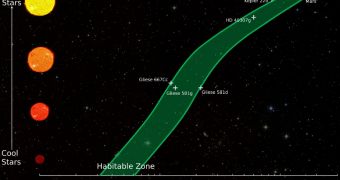The Goldilocks zone or the habitable zone is the region around a star where life on planets could potentially exist, that is, where water can be found in liquid form.
Whether water stays liquid on the surface of the planet depends on many things, but the biggest influences or, at least, the ones we can measure easily for faraway stars, are the distance from the planet to the star and the size of the star itself.
The habitable zone for the different categories of stars was calculated some 20 years ago and hasn't changed much since, until now.
A team at Penn State University, with members from the team that provided the first estimates, has now gone back and come up with an improved model for the habitable zone.
This new model could have a huge impact on what planets we deem fit for harboring life or not.
With hundreds of exoplanets discovered and thousands needing to be confirmed, the change could mean dozens or more planes could now find themselves inside the habitable zone or, conversely, outside of it.
Having an estimate of the habitable zone can help astronomers decide on which planets to focus their detailed analysis in the hopes of finding signs of life or at least planets comparable to Earth in the galaxy.
The changes in the model haven't resulted in huge differences in the habitable zone for various stars, but they are significant.
For example, for our own solar system the old model showed that life could exist on a planet orbiting at a distance of 0.96 AU to 1.67 AU where 1 AU is the distance between the Earth and the sun.
With the new model, the numbers are 0.99 AU to 1.7 AU, which is quite surprising since it means that the Earth is at the very limit of the habitable zone for our solar system. Overall, the new number suggests that habitable zones extend further out than previously thought.

 14 DAY TRIAL //
14 DAY TRIAL //